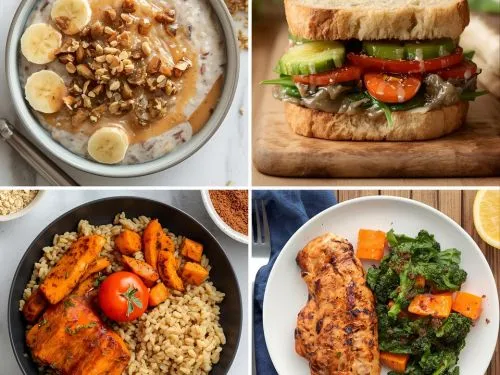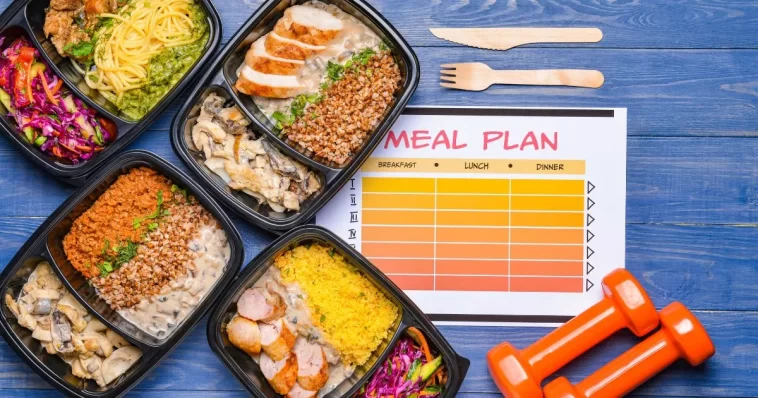Optimizing what you eat before and after exercise is essential for both performance and recovery. Pre‑workout meals supply the energy needed to sustain effort, while post‑workout meals help rebuild muscle tissue, restore glycogen, and reduce inflammation. According to current nutrition guidelines, a combination of carbohydrates and protein at appropriate times supports optimal recovery.
The timing of these meals can affect efficiency. Recent reviews suggest consuming a balanced pre‑workout snack about 30 to 90 minutes before training, depending on individual digestion and workout length. After exercise, supplying 20–40 grams of high‑quality protein along with carbohydrates can stimulate muscle repair and glycogen replacement.
Below are 10 of the best workout meal ideas, five for before training and five for after, that combine evidence‑based nutrition with real‑world convenience, using foods and combinations praised in recent 2025 sources.
Pre and Post Workout Meals: 10 Best Choices for Recovery
1. Oatmeal With Banana, Almond Butter, and Yogurt
This classic pre‑workout bowl offers a mix of slow‐digesting carbohydrates, fruit sugar, and moderate protein. Prepare a serving of rolled or steel‑cut oats, top with a sliced banana, one tablespoon of almond butter, and a dollop of plain yogurt. The oats provide steady energy throughout the workout, while the banana and almond butter deliver quick-access carbs and little fat to avoid digestive issues. According to sports nutrition guidelines, pairing moderate protein with easy-to-digest carbs about 1–1.5 hours before training supports performance.
2. Whole Grain Bread Sandwich With Lean Protein and Vegetables
A meal built on whole-grain bread, lean protein, and vegetables delivers solid fuel if you eat 2–3 hours before training. For instance, combine grilled chicken breast (about 150 g), slices of whole grain bread, and a handful of greens or tomato. This provides roughly 30–35 grams of protein and over 100 grams of carbohydrates, making it ideal for strength or longer endurance sessions.
3. Greek Yogurt With Berries and Honey
Greek yogurt paired with mixed berries is a balanced and easily digestible snack 45–60 minutes before a workout. The yogurt offers high‑quality protein (whey and casein), and the berries supply natural sugars and antioxidants. This combination is frequently recommended in 2025 pre-/post‑workout nutrition guides.
4. Banana and Nut Butter With Hydration
For early-morning training or when time is tight, a simple banana with a tablespoon of peanut or almond butter, plus a glass of water (or light electrolyte drink), makes a highly effective pre‑workout snack. It aligns with recommendations from sports dietitians emphasizing fast-digesting carbs and moderate protein.
5. Protein Shake With Instant Oats and Fruit
When ready-to-drink or homemade shakes are preferred, blend a scoop of whey or plant-based protein powder with instant oats, a banana, and water or milk. This combination yields a balanced ratio of protein (~30 g) and quick-to-digest carbohydrates (~70–110 g, depending on portions), as suggested by strength training guides.
Post‑Workout Meal Ideas (Recovery and Repair)
6. Grilled Chicken With Brown Rice and Vegetables
A staple for post‑workout recovery, this meal provides lean protein, complex carbohydrates, and micronutrients. Grilled chicken (about 25–30 g protein) paired with brown rice and a mix of steamed vegetables replenishes glycogen and supports muscle repair. This combination is frequently cited in recovery meal roundups for 2025.
7. Salmon With Sweet Potato and Greens
Salmon is rich in omega-3 fatty acids, which help reduce inflammation, while sweet potatoes offer complex carbs to rebuild glycogen stores. Adding a side of greens, such as spinach or asparagus, boosts micronutrient intake. According to recent guides, this anti‑inflammatory, nutrient-dense combo is among the top recovery meals.
8. Greek Yogurt Protein Bowl With Berries and Honey
Another yogurt-based option, but tuned for recovery: mix one cup of Greek yogurt with mixed berries, a drizzle of honey, and optionally some granola or chia seeds. The protein in the yogurt supports muscle rebuilding, while berries offer antioxidants, and honey gives a fast carb boost.
9. Tuna With Whole‑Grain Crackers or Wrap
Tuna is a lean, high-quality protein source (roughly 20 grams per 3-ounce serving) and also supplies healthy omega-3 fats for recovery. Pair it with whole wheat crackers or wrap it in a whole-grain tortilla, and add a handful of raw vegetables for fiber and micronutrients. This meal is recommended in the recent 2025 lists of optimal post‑workout foods.
10. Cottage Cheese With Pineapple or Banana
Cottage cheese is rich in casein protein, which digests slowly and supports muscle repair over a more extended period. Pairing it with pineapple, banana, or even a small handful of nuts creates a balanced snack that regenerates muscles and restores energy. According to dietitians, this is a great choice when a full meal isn’t possible immediately after training.

How These Meals Reflect 2025 Nutrition Trends
Emphasis on Balanced Macronutrients
Current 2025 nutritional guidance reinforces the importance of combining both carbohydrates and protein before and after exercise. Rather than relying solely on protein shakes, experts now favor meals that offer a mix of macronutrients. For example, dietitians recommend cottage cheese with almonds and a banana post‑workout due to its balance of protein, carbs, and healthy fat.
Anti‑Inflammatory Foods for Recovery
Foods high in omega-3 fatty acids (such as salmon) and antioxidant-rich fruits (like berries and pineapple) are prominent in modern recommendations. These ingredients help reduce inflammation and support long-term recovery.
Accessibility and Practicality
Many of these meals use everyday ingredients that are easy to prepare, portable when needed, and affordable. Pre‑workout options like banana + nut butter or yogurt + fruit require minimal cooking, while post‑workout meals such as grilled chicken and rice can be batch‑prepared for meal prep routines. These practical strategies align with 2025 expert advice.
Personalized Nutrition
Personalization is trending in the fitness nutrition space. According to recent studies, using biometric or wearable data (such as from Apple Health or WHOOP) helps tailor pre‑ and post‑workout nutrition more precisely to individual energy needs and recovery patterns.
Brand and Product Examples from 2025
While whole foods are ideal, certain trusted brands and products support recovery when meals are not possible or optimal.
- Greek Yogurt: Many 2025 nutrition reviews recommend plain Greek yogurt from brands offering minimal additives (choose ones with live cultures).
- Protein Powder: For shake-based pre-workout or recovery, whey or plant-based powders are suggested. Brands tested for purity and transparency remain popular; third-party tested products like Transparent Labs (pre‑workout) and whey isolates are highly rated.
- Hydration / Electrolyte Drinks: Clean electrolyte formulations are widely encouraged for athletes who sweat heavily. Low-sugar or no artificial color options help rehydrate without unnecessary additives.
- Canned Tuna: For quick post-workout meals, shelf-stable, sustainably sourced tuna from reputable brands can be a convenient go-to.
- Cottage Cheese: Cottage cheese from grass-fed or additive-minimal dairy brands supports muscle recovery effectively.
Timing Tips and Strategic Pairing
- Pre‑Workout Timing
- For full meals (e.g., chicken sandwich), aim for 2–3 hours before training.
- For lighter snacks (e.g., yogurt or banana + nut butter), consume 30–90 minutes before your session.
- Post‑Workout Window
- The most efficient nutrient absorption occurs within 30 to 60 minutes after exercise, but recent research indicates a wider window of up to 4 hours can still support recovery.
- Prioritize a meal or snack that delivers 20–40 g of high-quality protein and sufficient carbohydrates to refill glycogen stores.
- Hydration and Electrolytes
- Replacing fluid and sodium lost through sweat is critical. Water or simple electrolyte drinks can be used along with solid food meals.
- Especially for longer or more intense workouts, consider electrolyte options that combine sodium, potassium, and minimal sugars.
- Anti-Inflammatory Support
- Include foods with omega-3s (like salmon) or antioxidants (berries, pineapple) in post-workout meals to support recovery and reduce muscle soreness.
- Functional whole foods (e.g., tart cherry, beetroot) may also be incorporated via smoothies, yogurt additions, or meal bowls if more advanced recovery is needed.
Meal Prep Strategies for Busy Schedules
- Batch cook proteins and carbs: Grill chicken, bake salmon, and roast sweet potatoes on your meal-prep day. Portion into containers for pre- or post-workout meals.
- Keep easy snack packs: Greek yogurt containers, bananas, nut butter packets, and whole‑grain bread can be stored in the fridge or gym bag for quick reach.
- Use portable jars or bowls: Assemble cottage cheese + fruit or yogurt + berries + honey in mason jars for ready-to-go recovery snacks.
- Freeze smoothie packs: Pre-portion fruit, oats, and other ingredients in freezer-safe bags; add liquid and protein powder when you’re ready to blend.
Common Mistakes to Avoid
- Skipping Carbohydrates: Without adequate carbs pre- and post‑workout, performance may suffer, and recovery slows.
- Overloading Fat or Fiber Before Exercise: High-fat, high-fiber foods before training can slow digestion and cause discomfort.
- Relying Only on Protein Shakes: While protein shakes are convenient, whole‑food meals offer more balanced nutrition for recovery.
- Neglecting Hydration: Not replacing sweat losses can impair recovery. Even if solid food is available, fluids are still essential.
- Ignoring Personal Needs: Everyone’s digestion, training intensity, and goals vary. Experiment with timing, portion sizes, and food combinations until you find what works best.
Enhance Training and Recovery With Strategic Meals
Implementing well-balanced pre- and post-workout meals can make a dramatic difference in how one feels during training and how one recovers afterward. The ten meals featured here combine current 2025 research with practical, accessible ingredients: complex carbohydrates, high-quality proteins, healthy fats, and recovery-supporting micronutrients.
A thoughtful approach to meal timing, hydration, and food quality helps maximize training benefits. Real-life examples, such as a yogurt bowl or grilled chicken with brown rice, offer flexibility for different schedules, dietary preferences, and workout styles. Use the ideas above as a foundation, adapt based on personal needs, and build a routine that supports long-term performance and wellness.



